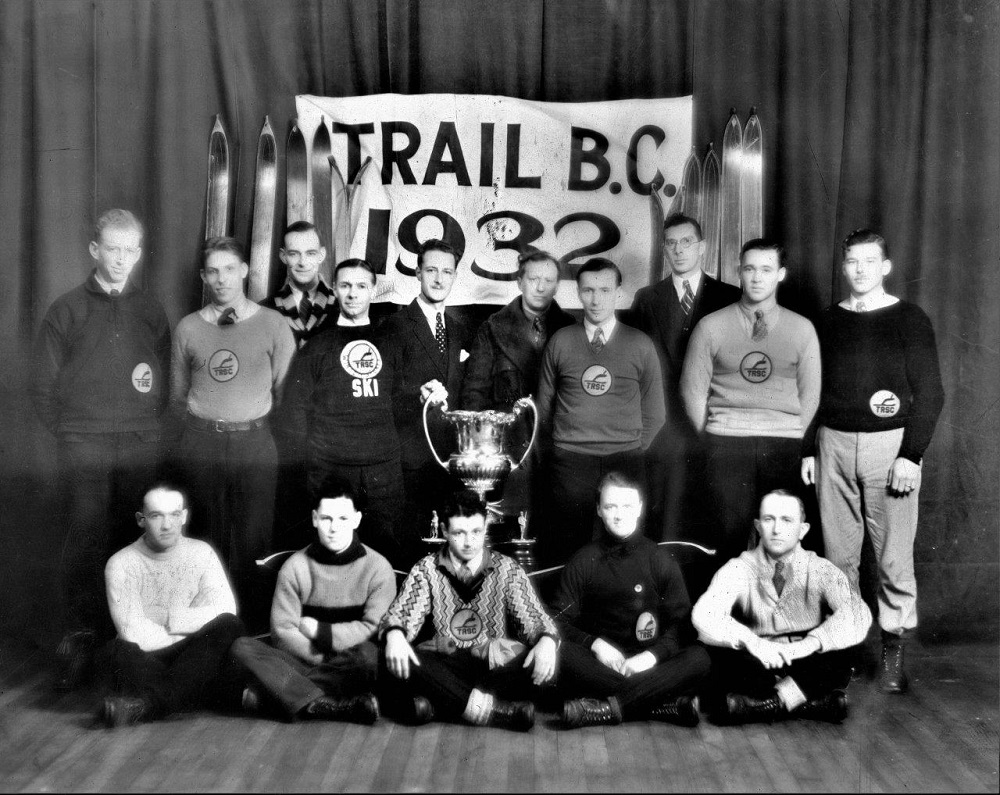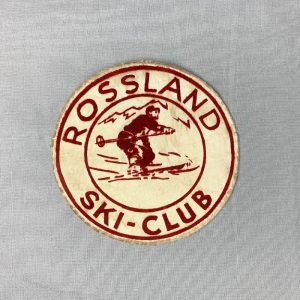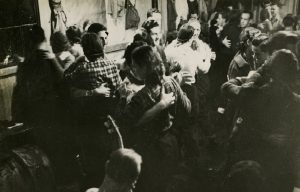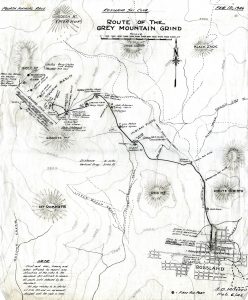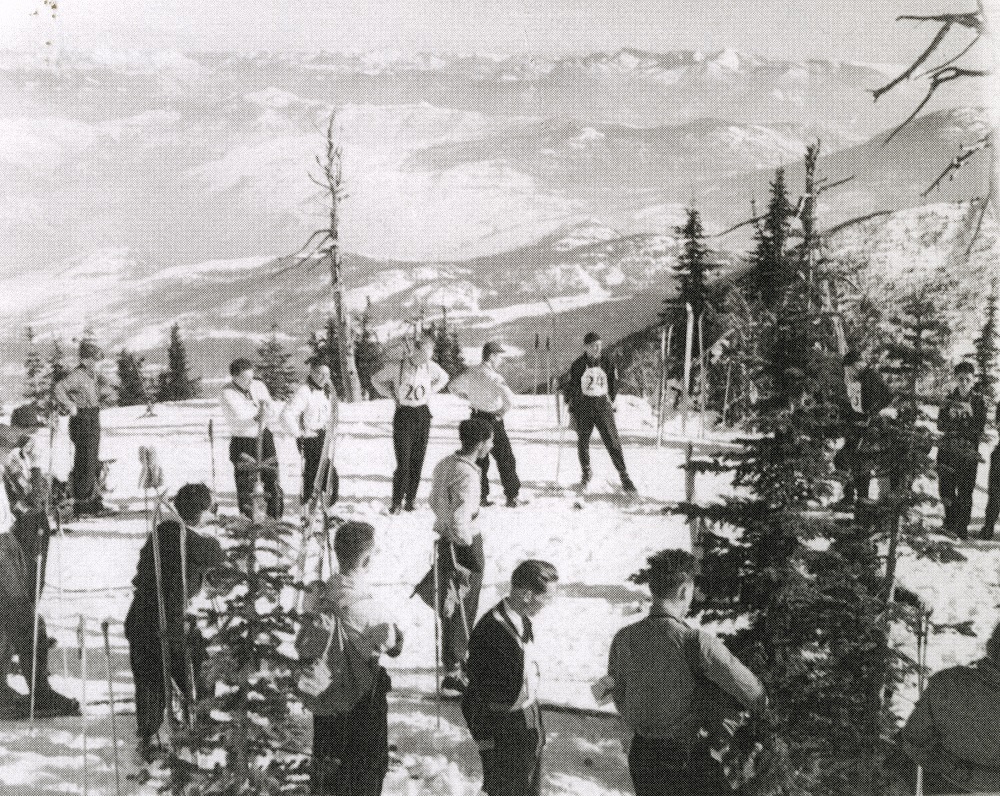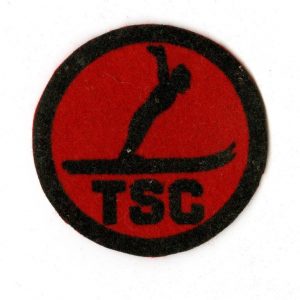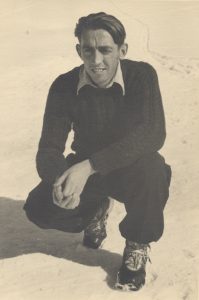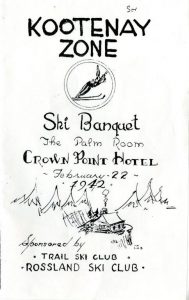The Ski Clubs 1929-1947
Despite the decline in popularity after 1918, skiing was revitalized in Rossland by the 1930s. Newly-formed ski clubs became community social hubs, constructing a number of cabins and ski hills. They also organized tournaments to further promote skiing in the area. Ultimately, these clubs ensured the future of skiing in Rossland.
Trail-Rossland Ski Club 1929-1933
In November 1929, Geoff Colls, Halfdon Bothun, Robert Lepsoe, and Ole H. Nyhus founded the Trail-Rossland Ski Club. This club was short-lived. In May 1933, Rossland members left the club, allegedly because there were too many members from the City of Trail. Still, the Trail-Rossland Ski Club was successful in reviving skiing in the district. They organized tournaments for ski-jumping and held cross-country ski races. The club had also developed two ski hills in Rossland and Trail by 1933. Using land leased from Don Paterson, the club developed a practice hill north of the Rossland reservoir. The club also constructed a jumping hill in Trail, located near the Old Trail Bridge on the west side of the Columbia River. Nels Nelsen, a prolific Norwegian ski-jumper living in Revelstoke, partially funded and supervised the construction of the Trail ski hill.
Rossland Ski Club (RSC) 1933-1947
In May 1933, a group of Rosslanders, including Trygve Nora, Harold Fox, Ivor Moen, Fred Hackney, and Harry O’Reilly, started the Rossland Ski Club (RSC). Similar to the Trail-Rossland Ski Club, the RSC’s purpose was to work towards improving and advancing skiing in the area. Their first action toward this objective was to find a suitable ski hill and build a club cabin. The club members started by skiing in the fields around a log cabin they were permitted to use at Barrie’s Ranch on Deer Park Mountain, west of Rossland. However, they quickly moved locations to develop better facilities. In the fall of 1934, the members constructed a new club cabin on Monte Cristo Mountain across from the reservoir on George Topliss’ property.
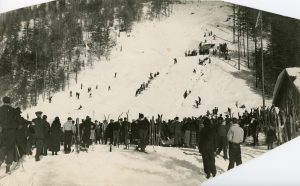
Rossland Ski Club Jump Hill, circa February 1937. Jumping continued to be a major spectacle for locals until the 1950s
This new location provided more skiable hills, while the new cabin was large enough to host social gatherings. Over the next fourteen years, the members continued to volunteer countless hours to develop and maintain the ski area. The club executives held work parties each fall to clear the ski field and improve the cabin. In January 1938, the club members successfully added electricity to the cabin and the ski hill. This upgrade added to the already popular Wednesday evening skiing culture as night skiing and club parties were now supported by adequate lighting.
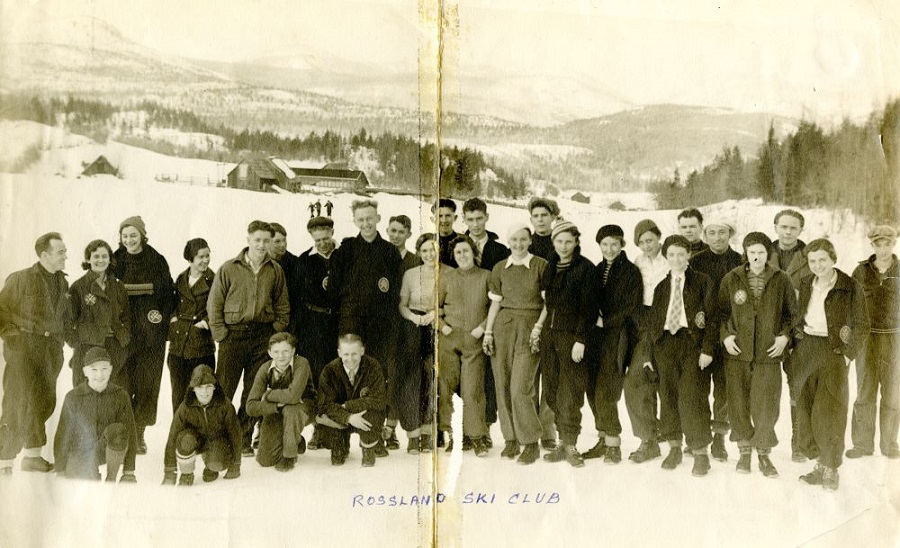
Rossland Ski Club. Back row left to right: Dan McNaughton, Islay Terhune, Daris Jerzick, Hinslin Churchill, Bob Hammy, Gordon Lynn, Lester Brown, Harry O’Reilley, Stewart Jameson. Front row left to right: Cummingham, Sigmund By, Dianne Hammay, Betty Wright, Elsie Johnson, Mary Mchlonell, Nina Jackson, Dorothy Stevens. Billie Wright, Helen Stevens. Kneeling left to right: unknown, unknown, Ed Cullinane, Harold Fox
The RSC also hosted several tournaments, including the famous Grey Mountain Grind (the “Grind”). The Grind ran annually from 1943 to 1946. In 1947, the club cancelled the race due to icy stretches and a lack of snow. The Grind was a gruelling competition where participants had to hike up to the top of Grey Mountain to get to the starting line. The route crossed 10.5 kilometres (6 ½ miles) of terrain with a 975 metres (3200 feet) vertical drop and ended on Spokane Street near Esling Park in Rossland. The Grind involved volunteers of all ages to make sure it ran smoothly. Kids too young to race would pre-set the course, while others recorded the competitors’ race times.
Trail Ski Club (TSC) 1933-1947
After the departure of the Rossland members, the Trail-Rossland Ski Club continued to operate under the management of the Trail members. The club’s name was changed to the Trail Ski Club (TSC) in 1934 at the request of the RSC. In September 1935, the TSC amalgamated with the Trail Ski Cabin Association. They built a club cabin near the Trail-Rossland practice hill with volunteer labour and money previously raised by the association. Over the years, the members made a proactive effort to ensure that skiers received lessons. As a result, the TSC developed an executive position called Hill Captain. This position was responsible for giving junior and beginner lessons as well as planning tournaments. To further improve the quality of coaching available to members, the club recruited a professional instructor, Ches Edwards, in 1941. Ed Stiles, Honorary President, orchestrated this development after taking a ski lesson from Ches in Banff, Alberta. Ches would eventually go on to cultivate many top-notch skiers from the area.
The fame of a racer is mortal; with the prime of his glory, his fame is already fated to die. To be a good teacher is something more lasting. That is why I find it more satisfactory to teach and impart my knowledge than to thrill the spectators for only a minute or two in a breath taking down hill race, etc.
– Ches Edwards
In his first year of coaching, Ches offered advanced and beginner ski classes for $0.50, with advanced lessons limited to 10 students. Despite being a TSC ski instructor, he gained prominence with RSC members over the years. By 1944, the clubs held competitions for the junior boys to see who would earn a spot in Ches’ ski lessons.
Coming Together: Rope Tow (1940-1942) and Kootenay Zone Tournament
Despite Trail and Rossland skiers separating and developing a quasi-rivalry, the clubs worked together on some major ski activities. For example, in 1940, members of each club and the Rossland Junior Board of Trade founded the Trail Rossland Rope Tow Association to build a rope tow on Red Mountain. The project was a success. On January 19, 1941, they held a grand opening to celebrate the newly-constructed rope tow. It took 80 volunteers and 1300 hours of work to complete. The clubs sourced an old golf club tractor engine and a rope from an old mine. The association and rope tow only operated for two years before wartime rationing and restrictions shut down the operations.
The Trail and Rossland ski clubs also planned major Canadian Amateur Ski Association (CASA) races together. In October 1938, the cities of Rossland, Trail, Nelson, and Kimberley joined CASA to form the Kootenay Zone. By doing so, the ski clubs could more regularly host sanctioned CASA ski meets and compete against each other on a larger scale. The responsibility for organizing the Kootenay Zone tournament rotated between the clubs. In February 1942, Trail and Rossland got their opportunity to host the competitions for the first time and chose to do it together. It was a major success and brought many ski competitors, ski enthusiasts, and observers to the area. They held races in cross-country (men only), downhill (men and women), slalom (men and women), and jumping (men only). Several Rossland and Trail skiers won these events.


